
 |
By Jay Bigalke
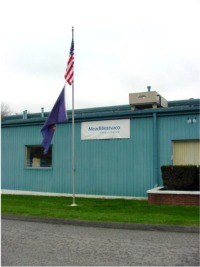 There's a new version of the non-profit sheep envelope, the Lincoln stamped envelope originally was embossed differently than the version that reached post offices, and there was almost a Love envelope this year.
There's a new version of the non-profit sheep envelope, the Lincoln stamped envelope originally was embossed differently than the version that reached post offices, and there was almost a Love envelope this year.
Philatelic journalists, APS employees, and employees of the U.S. Postal Service were given a tour in Spring 2003 of the MeadWestvaco (www.meadwestvaco.com) plant in Williamsburg, Pa., where stamped envelopes are manufactured. This facility is one of seven in the MeadWestvaco group and is the only one that produces stamped envelopes for the Postal Service. This year marks 36 years of stamped envelope production by MeadWestvaco. Every year approximately 30 billion stamped envelopes are printed on a high-speed web process.
Photographs inside the plant were prohibited during the tour.
The new contract with the USPS indicates many specifics that need to be followed in the production of stamped envelopes. An Executive Style envelope, which has a pointed flap and diagonal seam, is the style used. The weight of the paper is 20-24 pounds and the content of the paper is 30% recycled and 30% post-consumer. The paper is manufactured in DuBois, Pa., by Weyerhaeuser (www.weyerhaeuser.com). That company has the capability to emboss patterns into the envelopes, which currently is only used on the Official Mail stamped envelope. Additionally, holograms or patches are also possible and have been done in the past, but, due to the higher cost, the Postal Service has opted out.
The MeadWestvaco plant runs 24-7 and has 184 employees and 34 managers.
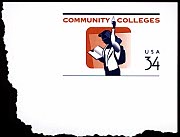 The process of multi-color close register printing is utilized and was put to the test with the Community Colleges envelope issued in 2001. Matching colors was difficult. MeadWestvaco has its own color mixing system but also utilizes the Pantone Matching System. All colors are mixed on site and plates are created there also.
The process of multi-color close register printing is utilized and was put to the test with the Community Colleges envelope issued in 2001. Matching colors was difficult. MeadWestvaco has its own color mixing system but also utilizes the Pantone Matching System. All colors are mixed on site and plates are created there also.
This year a new Love stamped envelope was issued in January. In the early stages a different design was prepared that was similar to the current 37¢ Stylized Love stamp issued last August. The number of colors on the envelope would have been possible, but the Citizens' Stamp Advisory Committee voted down the design and chose the Nurturing Love stamp envelope design instead.
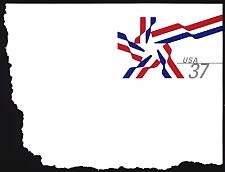 The Ribbon Star stamped envelope in the #10 format was being printed while we went on the tour. Additionally, there was a station where the personalized stamped envelopes were being imprinted with return addresses. These envelopes are ordered through Stamp Fulfillment Services in Kansas City. The return addresses are printed with a digital printer. In the past a lead die was made for each address, and then melted down and reused. Concerns about the safety of this process led to the digital process.
The Ribbon Star stamped envelope in the #10 format was being printed while we went on the tour. Additionally, there was a station where the personalized stamped envelopes were being imprinted with return addresses. These envelopes are ordered through Stamp Fulfillment Services in Kansas City. The return addresses are printed with a digital printer. In the past a lead die was made for each address, and then melted down and reused. Concerns about the safety of this process led to the digital process.
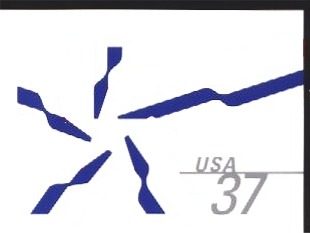 The printing of the Ribbon Star envelopes is a one-step process, except for the #9 security envelope in which the 37¢ denomination and security lining are printed the offset press. All others are Flexo printed with a phosphor taggant application. The envelopes begin as a roll of paper; the first step in the process the application of the ink. In the case of the Ribbon Star, four "colors" are applied: red, blue, gray, and the phosphor tag. While we went by the machine they had stopped it as the red ink was running low. Only one envelope that I saw on the entire tour was a blatant error and it was right at the point where they stopped the press. The red color was completely missing from the envelope. I was told that that box will be flagged and the error envelopes will be recycled. A mock-up of what I saw is pictured here.
The printing of the Ribbon Star envelopes is a one-step process, except for the #9 security envelope in which the 37¢ denomination and security lining are printed the offset press. All others are Flexo printed with a phosphor taggant application. The envelopes begin as a roll of paper; the first step in the process the application of the ink. In the case of the Ribbon Star, four "colors" are applied: red, blue, gray, and the phosphor tag. While we went by the machine they had stopped it as the red ink was running low. Only one envelope that I saw on the entire tour was a blatant error and it was right at the point where they stopped the press. The red color was completely missing from the envelope. I was told that that box will be flagged and the error envelopes will be recycled. A mock-up of what I saw is pictured here.
In the next step the roll of paper is turned upside down and fed through a machine that slices the roll into the individual envelopes. The style of the Executive envelope allows for a unique layout and only 2% of what is sliced off becomes waste.
Next, gum is applied to the flaps and the envelope is folded. A long conveyor belt takes the envelopes up and around and then folds the last flap at the top. The machine automatically counts out the envelopes and places them in boxes of 500.
There are many quality control checks to make sure that everything is working correctly and the envelopes all look the same. This would explain why it is extremely rare to find an error on a stamped envelope.
Additionally, in the past MeadWestvaco also banded U.S. Postal Service stamped envelopes with a thin piece of paper in packs of 5 envelopes. We were told that in the last contract the Postal Service discontinued them, as it was suspected that the person who mailed anthrax with the 34¢ Eagle stamped envelope probably purchased them from a vending machine. Therefore, as of right now, this five-pack product is not available on the 37¢ Ribbon Star.
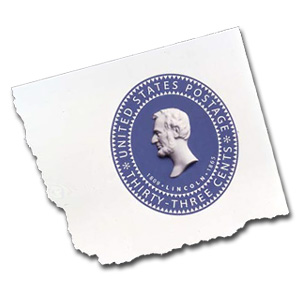 An interesting note was brought up regarding the 33¢ Lincoln stamped envelope. In the early stages of production, MeadWestvaco printed prototypes of the envelope with the bust of Lincoln embossed. The envelopes that were issued were embossed differently.
An interesting note was brought up regarding the 33¢ Lincoln stamped envelope. In the early stages of production, MeadWestvaco printed prototypes of the envelope with the bust of Lincoln embossed. The envelopes that were issued were embossed differently.
I asked if anything new had been printed recently and to my surprise the answer was yes. The (5¢) non-profit Sheep stamped envelope went back to press in late March-early April. For those who collect paper varieties on postal stationary, this will be a new variety as it will be on the same paper used currently for the Ribbon Star stamped envelopes.
©2003 de Vries Philatelic Media